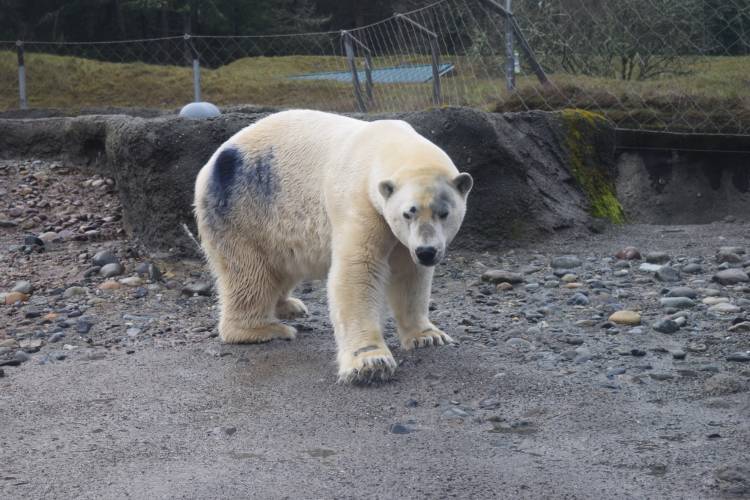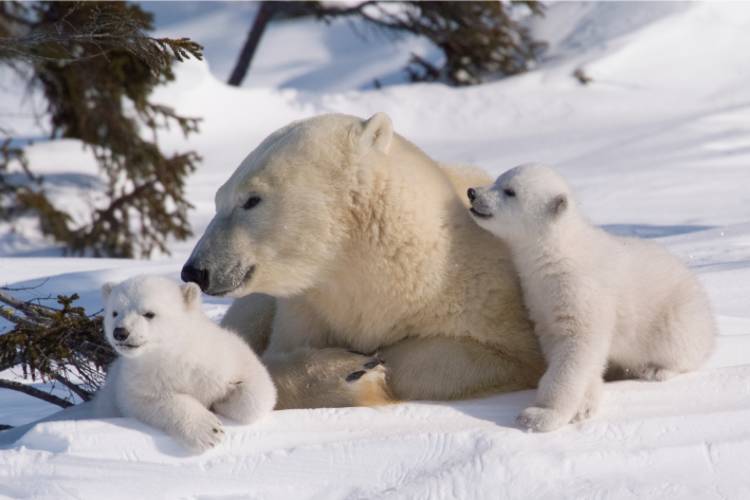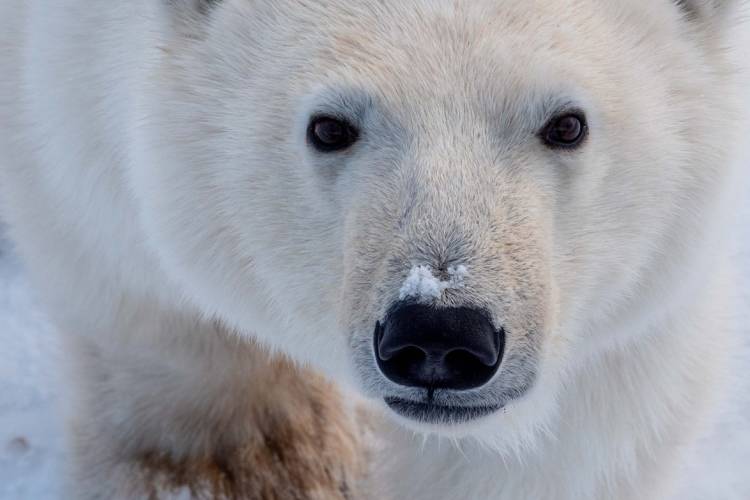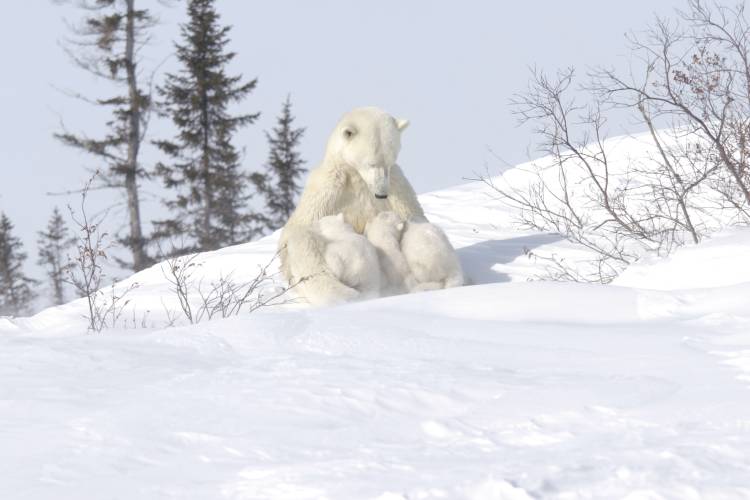A new Masterplan by the Polar Bear Research Council provides a roadmap to the most critical studies needed for polar bear conservation; from energetics to nutrition to reproduction, polar bears in zoos can help fill knowledge gaps that benefit their wild peers.
Bozeman, Montana — January 26, 2022 — Polar Bears International is supporting a team of researchers from leading zoos and aquariums involved in the Polar Bear Research Council (PBRC) in devising a Masterplan to advance the understanding of polar bear biology and management by participating in scientific research that will help protect the world’s polar bears. Today the PBRC released the 2022 PBRC Research Masterplan, a living document that describes the highest priorities for, and most recent findings from, zoo-based polar bear research. Download the Masterplan here.
In 2018, Polar Bears International supported the efforts of the Association of Zoos and Aquariums (AZA) in forming the Polar Bear Research Council (PBRC). Composed of zoo professionals and polar bear researchers, the Council focuses on keeping research current with emerging scientific questions regarding polar bears in the wild within the four main areas: Field Techniques, Health and Welfare, Physiology and Behavioral Ecology, and Reproductive Physiology. Zoos present a unique ability to fill critical knowledge gaps; they can also help develop and calibrate new research methods and technologies before they are deployed in the field. Bears in managed care can be repeatedly observed and sampled over long time periods—allowing sample size and replication not possible in the wild.
Collaborative efforts to understand and protect polar bears couldn’t come at a more urgent time. The International Union for Conservation of Nature estimates that just 26,000 polar bears remain across their range, which includes the U.S. (Alaska), Canada, Russia, Greenland, and Norway (Svalbard). The polar bears’ continued survival depends on human action to transition away from burning fossil fuels for energy like coal, oil, and natural gas. Zoo-based energetics research in partnership with field researchers was pivotal in the groundbreaking report that if we stay on our current greenhouse gas emissions path, polar bears could disappear by the end of the century.
“I’ve spent most of my career conducting research on wild polar bears across the Arctic, which has confirmed the threat of global warming and that we must reduce our reliance on fossil fuels in order to protect future generations of polar bears,” says Steven C. Amstrup, Ph.D., chief scientist at Polar Bears International, adding, “My experience has also shown that some vital studies simply cannot be conducted in the wild, and findings from zoo-based research are crucial to informing population estimates, policy, and more.”
This year, in particular, scientists are making significant headway studying polar bear nutrition, fur growth patterns and reproduction in zoos. Examples of PBRC-endorsed studies recently completed or currently in progress include:
Better understanding fur growth as a tool for studying the behavior and physiology of wild bears: In a study led by scientists at the University of Washington and the US Geological Survey, polar bears such as Blizzard, a 25-year-old male bear at Point Defiance Zoo & Aquarium, are participating in a fur study in collaboration with San Diego Zoo, Louisville Zoo, Assiniboine Park Zoo in Canada, Detroit Zoo, Oregon Zoo, Old Dominion University, Aarhus University, and Centre College. While fully awake, Blizzard volunteers to have a purple dot dyed on his coat and ingests a non-toxic biomarker (usually contained in some snacks) that is incorporated into the growing hair. Scientists then analyze the rate of fur growth, seasonal timing of hair growth, and the factors that affect these metrics, such as food intake, nutritional condition, size, age, sex, and environmental conditions. Understanding fur growth patterns help scientists better interpret stress levels, contaminant exposure, and the nutritional status using hair samples collected from polar bears in the wild.
Development of new tracking tags: Zookeepers and Veterinary staff are attaching prototypes of new, minimally-invasive, temporary tracking tags that attach to bear fur, developed by 3M and Polar Bears International. Tags have been attached to wild bears and also zoo bears like Kulu, a two-year-old male bear at St. Paul Como Park Zoo. Bears like Kulu live in diverse settings ideal for testing the prototype’s performance under various conditions, gaining critical information about when and why the tags fall off–information that they would be unable to obtain from wild bears roaming in the Arctic. The new tags will help scientists gain insights into polar bear movement patterns and habitat use, linking the contributions of bears like Kulu to the conservation of polar bears in the wild. Zoos participating in the “Burr on Fur” research project include Point Defiance Zoo & Aquarium, Kansas City Zoo, Columbus Zoo and Aquarium, Assiniboine Park Zoo in Canada, San Diego Zoo, Como Park Zoo, Oregon Zoo, Louisville Zoo, and Maryland Zoo in Baltimore.
Improving bear nutrition and health: Polar bears at Como Zoo, Brookfield Zoo, Columbus Zoo, Detroit Zoo, Seneca Park Zoo, and the Alaska Zoo recently provided critical information on macronutrient requirements of polar bears in collaboration with a study led by the U.S. Geological Survey and Washington State University. In combination with studies of wild bears, feeding trials with zoo polar bears demonstrated that polar bears have low protein requirements and that maintaining bears on lower protein diets is critical to support long-term kidney health. On higher protein diets, polar bears expend energy excreting nitrogen that exceeds their requirements, thereby increasing energetic costs and taxing the kidneys. This has important implications for interpreting the changing diets of wild bears and ensuring optimal health of zoo polar bears. The studies confirmed that polar bears consume the highest fat diet of any species in the world which supports the high energy requirements needed to support their large body size in an Arctic environment.
Improved understanding of reproduction: Scientists at the Cincinnati Zoo & Botanical Garden are using cutting-edge technology to understand and improve reproduction in polar bears, working with samples from more than 60 polar bears at 31 zoos. Voluntary blood samples are being used to study how the bear’s reproductive hormones fluctuate across the entire calendar year. The findings will help field researchers assess pregnancy in wild polar bears and will also help ensure genetic diversity.

















